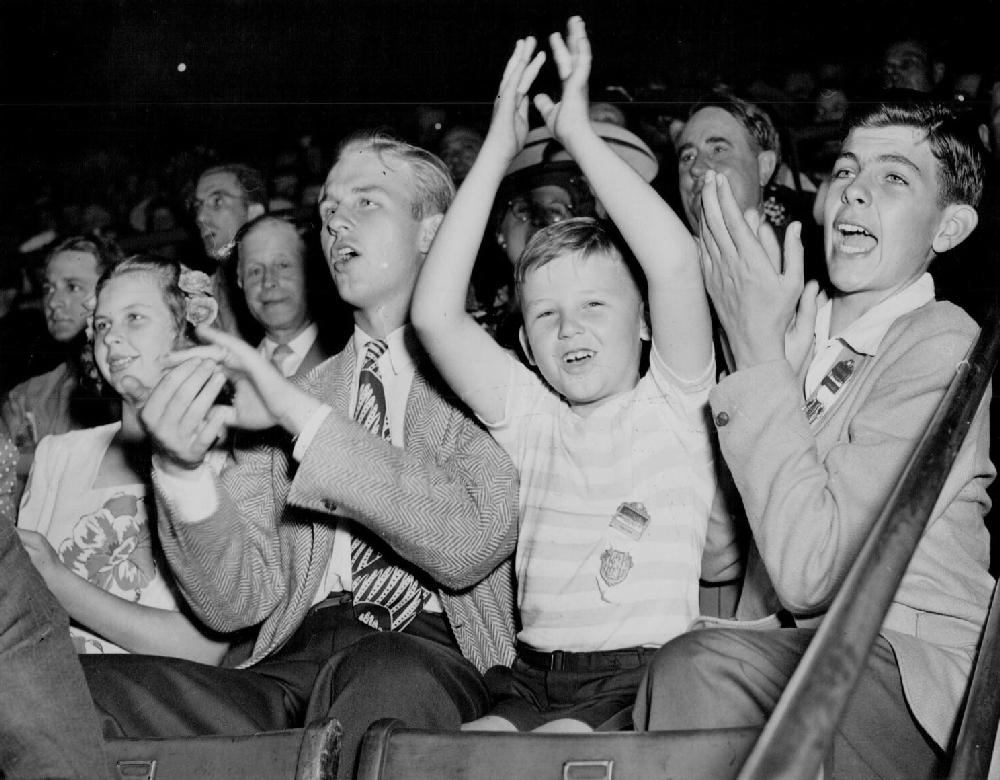
United States Elections: Presidential Elections (1944)

Figure 1.--There was not doubt as to who the Democrats would nominate in 1944 with World War II still raging. Oklahoma Governor Robert S. Kerr was chosen to deliver the keynote addres. He was a vigornous supporter of the New deal and from the outset of the War a staunch proponent of the war effort. He would play a back-room role in the movement to replace Vice-President Henry Wallace. The press caption here read, "Kerr children liked pop's keynote speech Chicago Ill.: The four children: Governor Robert S. Kerr of Oklahoma wildly applaud their father's keynote speech delivered at tonight's sesion of the Democratic National Convention." The photograph was dated July 19, 1944.
|
|
There was not doubt as to who the Democrats would nominate in 1944 with World War II still raging. Oklahoma Governor Robert S. Kerr was chosen to deliver the keynote addres. He was a vigornous supporter of the New deal and from the outset of the War a staunch proponent of the war effort. He would play a back-room role in the movement to replace Vice-President Henry Wallace. The President had left the Democrats in doubt as to his intentions in 1940. This time there was no Roosevelt chicanery. The only question at the convention was who would they would nominate for vice-president. Vice-President Henry Wallace was unpopular with party professionals, especially in the South. The President learning of the the opposition to Wallace among the delegates, allowed the Convention to choose his running mate. Senator Truman was the Convention's choice, primarily because party bosses were concerned about Vice-President Wallace left-wing orientatuin. Truman was at the time relatively unknown to the American people. The state of the Presiden's health was not widely known at the time. Few Americans realized just how consequential this choice would be. There were three major Republican candidates: Wendell Willkie who won the nomination in 1940 candidate; Ohio Senator Robert Taft who was the most prominant conservatives; and New York Governor Thomas E. Dewey who was noteable for his crime-busting efforts. Taft withdrew from the contest. And in the important Wisconsin primary, Dewey decissively defeated both Wilkie and General Douglas MacArthur. The Republicans nominated Dewey at their convention. The President's health was obviously declining. You can see it in the photographs taken in 1944. The public seems to have dismissed this. Govenor Dewey attempted to raise the issue, but to little effect. The War was going well both in Europe and the Pacific. The Republicans could only snipe at the President, actually taken on his wll known dog--Falla. Primarily they attacked the New Deal. These attacks had little resonance in a country absorbed with the War. And voters remembered that it was the President who warned about Hitller and the Japanese militarists when the Republicans were largely isolantionists. Roosevelt easily defeated Govenor Dewey in the election to win his fourth term. Curiously other than Maine and Vermont, the only states Dewey carried were in the Farm Belt of the Mid-West and West. These seems an unusual accomplishment for a suave New York govenor, especially as President Roosevelt's New Deal had attempted to address the farm problem. It would be Dewey's failure to hold the Farm Belt that would cost him the presidency in 1948.
CIH -- WW II

Navigate the Children in History Website:
[Return to the Main 20th century U.S. election page]
[Return to the Main U.S. election page]
[Return to the Main U.S. presidential page]
[Return to the Main U.S. political party page]
[Return to the Main U.S. history page]
[About Us]
[Introduction]
[Biographies]
[Chronology]
[Climatology]
[Clothing]
[Disease and Health]
[Economics]
[Freedom]
[Geography]
[History]
[Human Nature]
[Ideology]
[Law]
[Nationalism]
[Presidents]
[Religion]
[Royalty]
[Science]
[Social Class]
[Bibliographies]
[Contributions]
[FAQs]
[Glossaries]
[Images]
[Links]
[Registration]
[Tools]
[Children in History Home]
Created: 9:12 AM 9/14/2011
Last updated: 12:54 AM 6/16/2013



